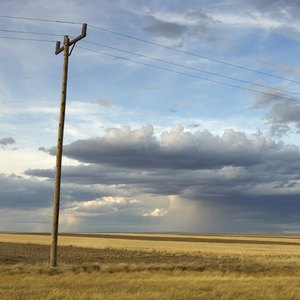
An easement gives a person or entity the right to make some use of non-owned property. It may be the installation of a gas pipeline or a roadway to access a person's property. Easements attach to property and are not extinguished by subsequent transfers. Numerous ways exist to create an easement. Anyone purchasing real property needs to determine what, if any, easements encumber the land and what rights those easements grant.
Express Grant by Instrument
An express grant by written instrument is the most common source of an easement. It is recorded in the appropriate governmental office for the county where the real property is located. The easement is executed by the owner of the land, the grantor, and goes to the person or entity obtaining the easement, or the grantee. An example is an easement to a municipality to install a sewer line on a portion of land.
Implied
The owner of a large tract of land splits up the land with one or more parcels that do not abut a public highway or road. The deeds to those tracts do not contain an easement granting ingress, egress and regress, that is, the right to cross the owner's property to reach the public road. An implied easement is created on the theory that the owner and purchaser expected that an easement would exist.
Necessity
When the owner of a landlocked tract of land cannot establish an implied easement, the remedy is an easement by necessity. Without a means of accessing the property, its value and use becomes worthless. The law does not allow this to happen. The easement created might not result in the closest roadway to the highway, but the property owner gets a means of access to the property.
Dedication
An easement by dedication can be created in two ways. One is done by a developer or other individual recording a map with roads. Unless the map indicates that the roads are private, recording of the map creates an easement across the roads by dedication. The other means is to refer to an unrecorded map in the deed description, thus dedicating the roads to public use as an easement of ingress, egress and regress.
Prescription
What the law calls "open and notorious use" establishes an easement by prescription. For example, a person uses a path or roadway across another's land openly, with the knowledge of the landowner, for a significant continuous period of time set by state law, like 20 years, and it is clear where the easement is being created. Once the time period elapses, the easement by prescription is created.
References
- National Paralegal College: The Creation of Easements
- The City of Portland Oregon: Dedicating Streets and Granting Easements
- Cornell University Law School Legal Information Institute: Easement
- City of Colonial Heights Department of Public Works. "Easements - What Is an Easement?," Page 2. Accessed March 11, 2020.
- Henderson County North Carolina. "Subdivision: Right-of-Way Frequently Asked Questions." Accessed March 11, 2020.
- Majr Resources. "What Is the Difference Between Easement & Right of Way?" Accessed March 11, 2020.
- Utah Department of Commerce. "Easements." Select "Is an Easement a Property Right?" Accessed March 11, 2020.
- Expert Law. "What Is an Easement - Easement Rights and Duties." Accessed March 11, 2020.
- Trulia. "Easements: Know Your Property Rights." Accessed March 11, 2020.
- New York State Attorney General. "FAQs About Real Estate." Accessed March 11, 2020.
- Florida's Title Insurance Company. "How To Read a Title Commitment." Accessed March 11, 2020.
- Brewer Offord & Pedersen LLP. "What Is This “Easement” Thing In My Preliminary Report?" Accessed March 11, 2020.
- California Department of Insurance. "Title Insurance - Introduction." Accessed March 11, 2020.
Writer Bio
Robert Alley has been a freelance writer since 2008. He has covered a variety of subjects, including science and sports, for various websites. He has a Bachelor of Arts in economics from North Carolina State University and a Juris Doctor from the University of South Carolina.

